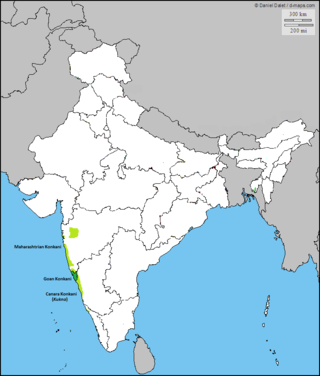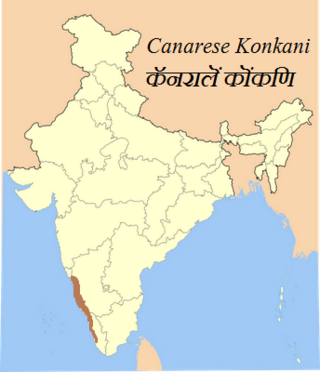Related Research Articles

Brahui is a Dravidian language, spoken by the Brahui and Baloch people, primarily in central areas (Brahuistan) of the Pakistani province of Balochistan; with smaller communities of speakers scattered in parts of Iranian Baluchestan, Afghanistan, and Turkmenistan. It is also spoken by expatriate Brahui communities in Iraq, Qatar, and the United Arab Emirates. It is isolated from the nearest Dravidian-speaking neighbouring population of South India by a distance of more than 1,500 kilometres (930 mi). The Kalat, Khuzdar, Mastung, Quetta, Bolan, Nasirabad, Nushki, and Kharan districts of Balochistan Province are predominantly Brahui-speaking.

The Dravidian languages are a family of languages spoken by 250 million people, mainly in South India, north-east Sri Lanka, and south-west Pakistan, with pockets elsewhere in South Asia.

Malayalam is a Dravidian language spoken in the Indian state of Kerala and the union territories of Lakshadweep and Puducherry by the Malayali people. It is one of 22 scheduled languages of India. Malayalam was designated a "Classical Language of India" in 2013. Malayalam has official language status in Kerala, Lakshadweep and Puducherry (Mahé), and is also the primary spoken language of Lakshadweep. Malayalam is spoken by 35 million people in India. Malayalam is also spoken by linguistic minorities in the neighbouring states; with a significant number of speakers in the Kodagu and Dakshina Kannada districts of Karnataka, and Kanyakumari, Coimbatore and Nilgiris district of Tamil Nadu. It is also spoken by the Malayali Diaspora worldwide, especially in the Persian Gulf countries, due to the large populations of Malayali expatriates there. They are a significant population in each city in India including Mumbai, Bengaluru, Chennai, Delhi, Hyderabad etc.

Kannada, formerly also known as Canarese, is a classical Dravidian language spoken predominantly by the people of Karnataka in southwestern India, with minorities in all neighbouring states. It has around 44 million native speakers, and is additionally a second or third language for around 15 million non-native speakers in Karnataka. The official and administrative language of the state of Karnataka, it also has scheduled status in India and has been included among the country's designated classical languages.

The Tulu language is a Dravidian language whose speakers are concentrated in Dakshina Kannada and in the southern part of Udupi of Karnataka in south-western India and also in the northern parts of the Kasaragod district of Kerala. The native speakers of Tulu are referred to as Tuluva or Tulu people and the geographical area is unofficially called Tulu Nadu.
The Kodava is a Dravidian language spoken in Kodagu district (Coorg) in Southern Karnataka, India. It is an endangered language. The term Kodava has two related usages. Firstly, it is the name of the Kodava language and culture followed by a number of communities from Kodagu. Secondly, within the Kodava-speaking communities and region (Kodagu), it is a demonym for the dominant Kodava people. Hence, the Kodava language is not only the primary language of the Kodavas but also of many other castes and tribes in Kodagu. The language has two dialects: Mendele and Kiggat.

Konkani is an Indo-Aryan language spoken by the Konkani people, primarily in the Konkan region, along the western coast of India. It is one of the 22 scheduled languages mentioned in the Indian Constitution, and the official language of the Indian state of Goa. It is also spoken in Karnataka, Maharashtra, Kerala, Gujarat as well as Damaon, Diu & Silvassa.

Tulu Nadu or Tulunad is a region and a proposed state on the southwestern coast of India. The Tulu people, known as 'Tuluva', speakers of Tulu, a Dravidian language, are the preponderant ethnic group of this region. South Canara, an erstwhile district and a historical area, encompassing the undivided territory of the contemporary Dakshina Kannada and Udupi districts of Karnataka State and Kasaragod district of Kerala state forms the cultural area of the Tuluver.
South Dravidian is one of the four major branches of the Dravidian languages family. It includes the literary languages Tamil, Kannada, Malayalam and Tulu, as well as several non-literary languages such as Badaga, Irula, Kota, Kurumba, Toda and Kodava.
Proto-Dravidian is the linguistic reconstruction of the common ancestor of the Dravidian languages native to the Indian subcontinent. It is thought to have differentiated into Proto-North Dravidian, Proto-Central Dravidian, and Proto-South Dravidian, although the date of diversification is still debated.
Irula is a Dravidian language spoken by the Irulas who inhabit the area of the Nilgiri mountains, in the states of Tamil Nadu, Kerala, and Karnataka, India. It is closely related to Tamil. It is written in the Tamil script.

Since the Iron Age of India, the native languages of the Indian subcontinent have been divided into various language families, of which Indo-Aryan and Dravidian are the most widely spoken. There are also many languages belonging to unrelated language families such as Munda and Tibeto-Burman, spoken by smaller groups.

Kolami is a tribal Central Dravidian language spoken in Maharashtra and Telangana states of India. It falls under the Kolami–Naiki group of languages. It is the most widely spoken Central Dravidian language.

The population of Kerala, India is a heterogenous group that comprises many ethnic groups that originated in other parts of India as well as the world, with distinctive cultural and religious traditions. While the majority of Keralites speak the Malayalam language, various ethnic groups may speak other languages as well.

Tulu Nadu State movement is aimed at increasing Tulu Nadu's influence and political power through the formation of separate Tulu Nadu state from Karnataka and Kerala. Tulu Nadu is a region on the south-western coast of India. It consists of the Dakshina Kannada and Udupi districts of Karnataka and Kasargod district up to the Chandragiri river in Kerala. The Chandragiri River has traditionally been considered a boundary between Tulu Nadu and Kerala from the fourth century AD onwards. The first call for a separate Tulu Nadu state was made just after the Quit India Movement in 1942 by Srinivas Updhyaya Paniyadi, a banker and a press owner from Udupi. Mangalore is the largest and the chief city of Tulu Nadu. Tulu activists have been demanding a separate Tulu Nadu state since the late 2000s, considering language and culture as the basis for their demand.
Karnataka is a state in the southern part of India. It was created on 1 November 1956, with the passing of the States Reorganisation Act. Karnataka is bordered by the Arabian Sea to the west, Goa to the north-west, Maharashtra to the north, Telangana and Andhra Pradesh to the east, Tamil Nadu to the south-east, and Kerala to the south-west. The state covers an area of 74,122 sq mi (191,976 km2), or 5.83% of the total geographical area of India. It comprises 30 districts. Kannada is the official language of Karnataka and as per the 2011 census is the mother tongue of 66.5% of the population. Various ethnic groups with origins in other parts of India have unique customs and use languages at home other than Kannada, adding to the cultural diversity of the state. Significant linguistic minorities in the state in 2011 included speakers of Urdu (10.8%), Telugu (5.8%), Tamil (3.5%), Marathi (3.4%), Hindi (3.2%), Tulu (2.6%), Konkani (1.3%) and Malayalam (1.3%).
Duruwa or Dhuruwa or Parji is a Central Dravidian language spoken by the Duruwa people of India, in the districts of Koraput in Odisha and Bastar in Chhattisgarh. The language is related to Ollari and Kolami, which is also spoken by other neighbouring tribes.

Canarese Konkani are a set of dialects spoken by minority Konkani people of the Canara sub-region of Karnataka, and also in Kassergode of Kerala that was part of South Canara.
Bellari is a Dravidian variety of India spoken by about 1,000 Bellara, a Scheduled Caste of Karnataka and Kerala. It is reportedly close to Tulu and Koraga, but it is not known if it is a separate language or a dialect of Tulu. A community of fifty families of basket-weavers lives in Kundapura Taluk in coastal Karnataka.
Byari or Beary is a geographically isolated dialect of Malayalam spoken by the Byaris who are part of the Muslim community in Tulu Nadu region of Coastal Karnataka and Northern Kerala. The community is often recognized as Byari s or Byari Muslims. Byari is influenced by Tulu phonology and grammar. Due to the trading role of the community, the language acquired loan words from other languages of Tulu and Arabic sources.
References
- ↑ "Gondi, Walmiki, Malhar, Korga: Mother tongues India risks losing". Hindustan Times. 4 May 2018. Retrieved 2 January 2021.
- 1 2 3 Bhat (1971), p. 2.
- ↑ Fairservis, Walter Ashlin (1997). The Harappan Civilization and Its Writing: A Model for the Decipherment of the Indus Script. Asian Studies. Brill Academic Publishers. p. 16. ISBN 978-90-04-09066-8.
- ↑ Stassen, Leon (1997). Intransitive Predication. Oxford Studies in Typology and Linguistic Theory. Oxford University Press. p. 220. ISBN 978-0-19-925893-2.
- ↑ Bhat (1971), p. 4.
- ↑ Bhat (1971), pp. 2, 4.
- ↑ Bhat (1971), p. 45.
- 1 2 Krishnamurti (2003), p. 68.